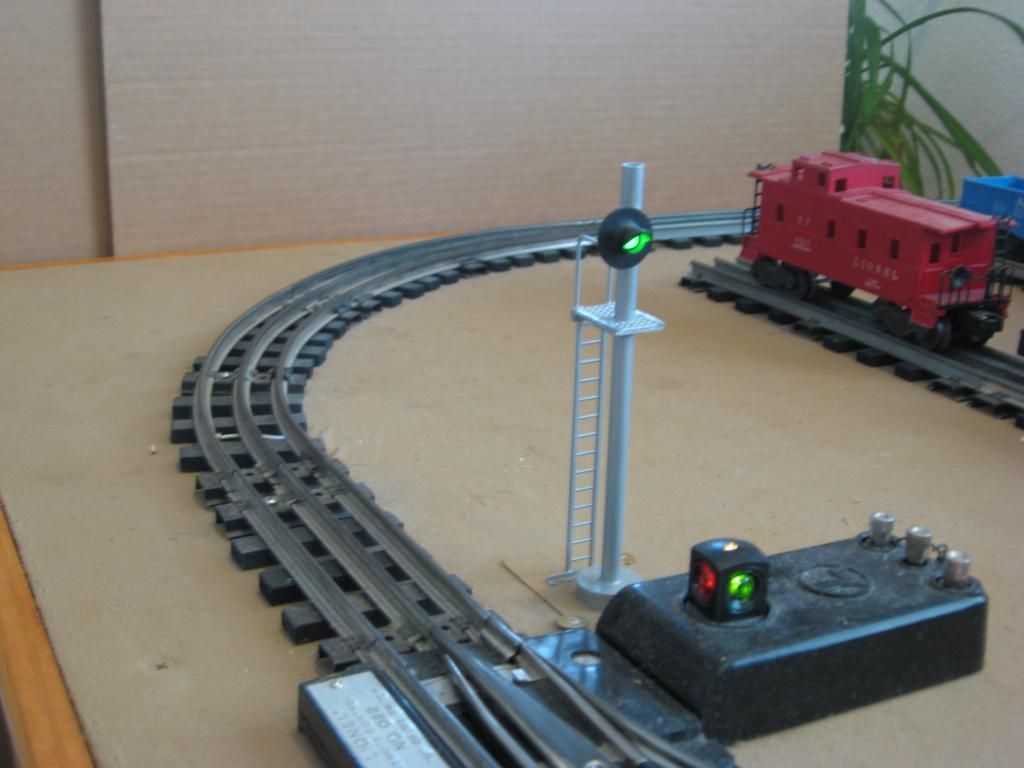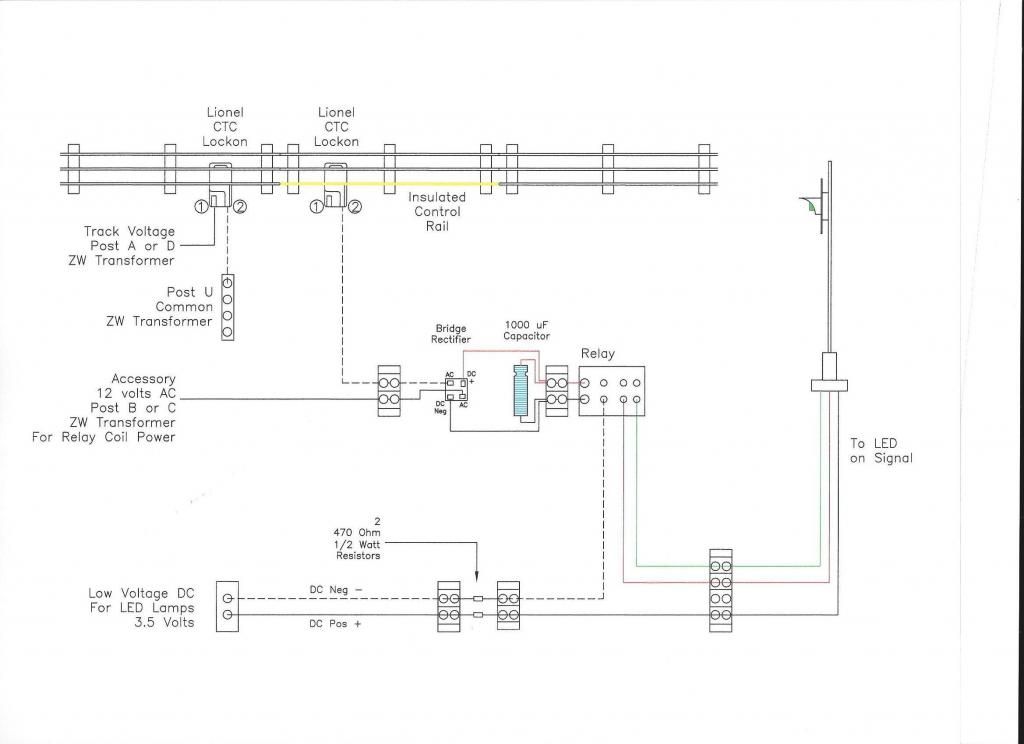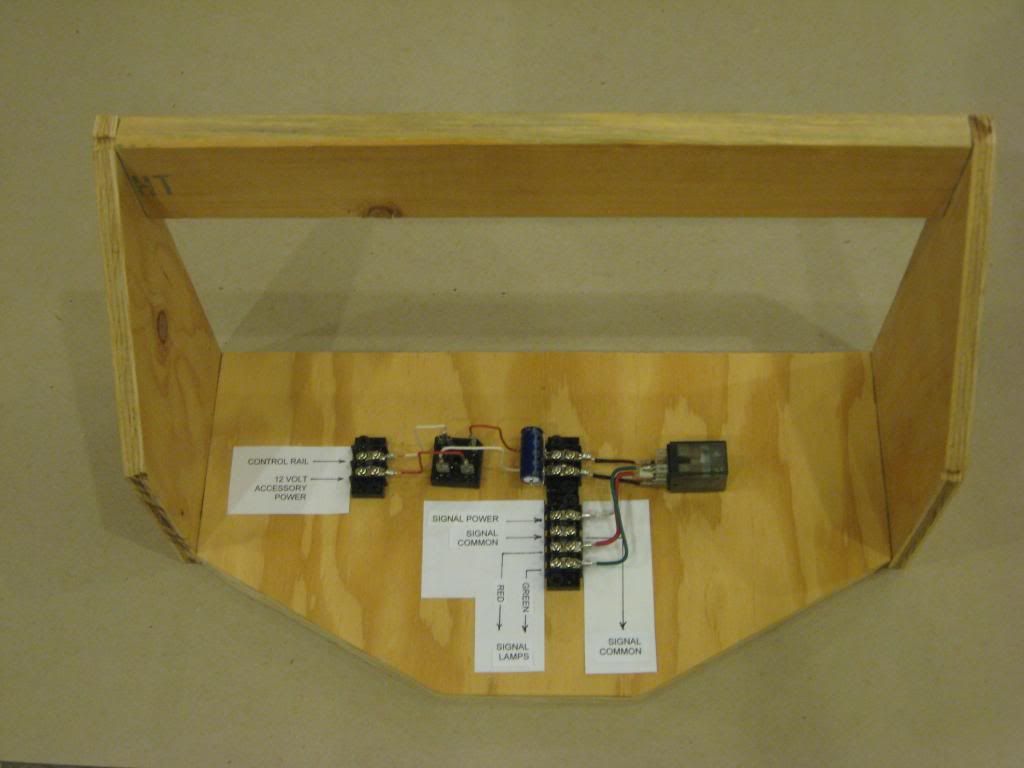Can someone let me know exactly what it will take to make this work?
Thanks in advance for any help. This place is a great resource to young enthusiasts like myself.
|




|
Replies sorted oldest to newest
I cannot tell off-hand. All of my materials are packed away. May I suggest that you locate Greenbergs "Wiring Your Lionel Layout" by: Peter H. Riddle PhD. It comes in three levels according to skill. Each has complete easy to understand diagrams. Well worth the investment IMHO
Forum member Dale H posted a collection of his circuits on another forum. here's a circuit for a three light with timed yellow triggered by an rail
That should give you a start. Just leave out the yellow and the timer.
Some are using the Infrared detection for the Asian suppliers on the bay. There US source with ready to go systems like Azatrax.
I am with Moonman on this... The link he provided brings you to J & C Studios site. I have found some great write ups, ideas, good explanations there. Between threads on the forum and the link he provided you should find the information you need.
Don't overlook the obvious when wiring signals.
Marx trains used a reversing unit that only had two positions. Essentially a latching relay. I use two to control the signal lights on my signal bridge.
When the train enters a block it triggers the Marx reversing unit (under the table) to switch the signal from green to red. When the train leaves the block it cycles the same Marx unit to switch the signal back to green.
Obvious, maybe not. Effective, yes.![]()
Don't overlook the obvious when wiring signals.
Marx trains used a reversing unit that only had two positions. Essentially a latching relay. I use two to control the signal lights on my signal bridge.
When the train enters a block it triggers the Marx reversing unit (under the table) to switch the signal from green to red. When the train leaves the block it cycles the same Marx unit to switch the signal back to green.
Obvious, maybe not. Effective, yes.![]()
Rkenny, yes that is exactly what I'm looking to accomplish. Do u know where I could get a latching relay?
Don't overlook the obvious when wiring signals.
Marx trains used a reversing unit that only had two positions. Essentially a latching relay. I use two to control the signal lights on my signal bridge.
When the train enters a block it triggers the Marx reversing unit (under the table) to switch the signal from green to red. When the train leaves the block it cycles the same Marx unit to switch the signal back to green.
Obvious, maybe not. Effective, yes.![]()
Rkenny, yes that is exactly what I'm looking to accomplish. Do u know where I could get a latching relay?
You really don't want a "latching" relay for your application. You want the relay to pick up when the train is in the block and drop out when it gone. A "latching" relay will remember the last known state of a condition until another condition "resets" it.
You can find them used on ebay. Pretty easy to clean and repair if necessary. Go to ebay and search for Marx e unit.
Most AC 'latching relays used commercially are bi-stable units. This means there are two coils with a common feed to operate, this is much like a turnout motor. So, which coil do you activate?
The problem with switching block lights is that you need to know which coil to activate. The beauty of E-units is they simply cycle each time power is applied (single coil). All you need is a isolated rail entering and leaving the block. Light switches when entering the block and switches back when leaving regardless of the direction of travel.
I have scratchbuilt my own searchlight signals using Evergreen Styrene tubing. For the target face I used a 1/4 washer. The LED is a Radio Shack 276-0028. I use 24 gauge telephone wire for the signal. The ladder is Plastruct.

Here is a drawing of my Relay set up. All parts are from Radio Shack. For the DC power supply I used a small cheap DC power pack. I have the output set at 3.5 volts DC. You could also use a small Wall Wart - like one from a old sell phone charger.

I built a wood shelf that I hang under the benchwork

Here is a close up of the finished set-up. I use a telephone jack box to connect to the telephone wire from the signal. The blue and white wires on the back side of the relay go to a second relay controlling another signal.

Let me know if this helps.
Steve
You really don't want a "latching" relay for your application. You want the relay to pick up when the train is in the block and drop out when it gone. A "latching" relay will remember the last known state of a condition until another condition "resets" it.
The author of this post seems to have missed the point. The problem with his system is that it only indicates a train that just happens to be on his detector. If the block is longer than the train the signals can indicate clear when the block is not. So where do you put a single detector? Front of the block (which will be the rear if the train is going the other way), rear of the block, center...?
The latching relay is cycled when entering the block and when leaving. Sure you need more detection, but if your simply using isolated third rails as I am this is not difficult. Plus this system with two detectors is not direction sensitive. It works equally well in either direction.
Access to this requires an OGR Forum Supporting Membership
